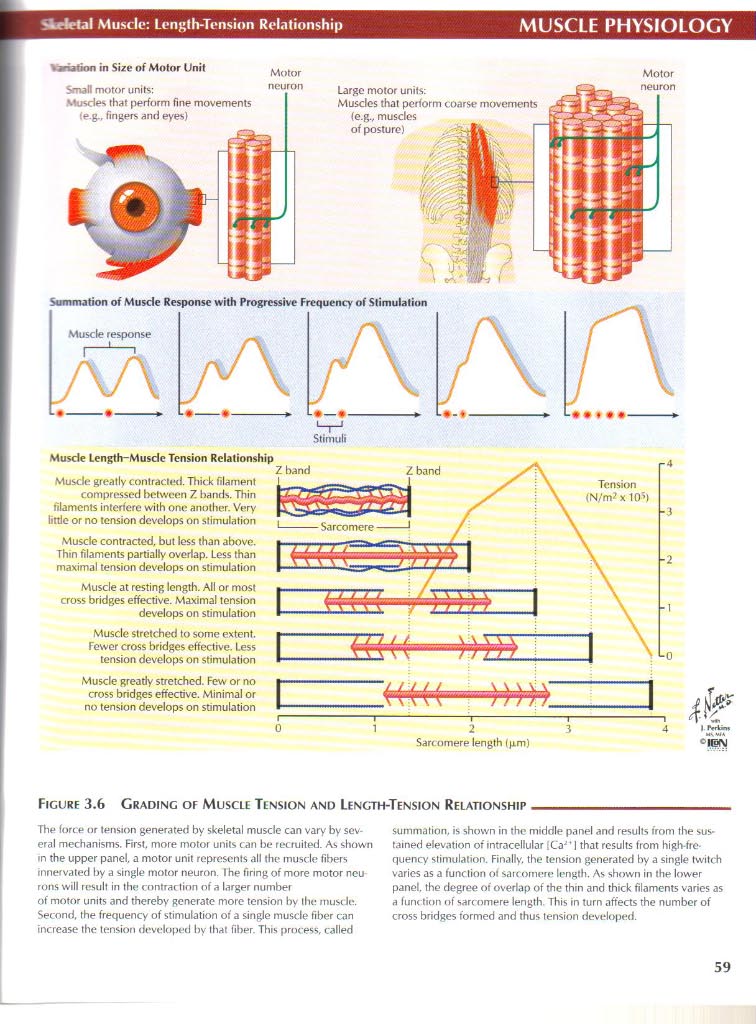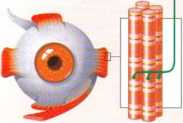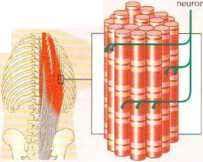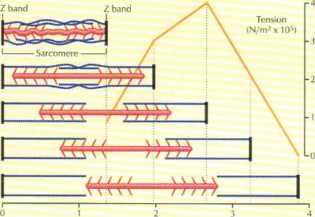78877 netter48

MUSCLE PHYSIOLOGY
>*rietal Muscle: Length-Tension Relationship


'»ariation in Size of Motor Unit
Smali motor units:
Musdes that perform fine movements (e.g.. fingers and eyes)
Largo motor units:
Musdes that perform coarse movements (e.g., musdos of posturo)

Stimuli

Sarcomere length ipm)

Musde Length-Musde Tension Relationship
Musde greatly contracted. Thick diament compressed between 7. bands. Thin filaments interfere wilh ono another. Very littJo or no tension dovelops on stimulation
Musde contracted. but less than above. Thin filaments partialły ovoriap. Less than maximal tension dovelops on stimulation Musde at resting longth. Ali or most cross bridges effective. Maximal tension develops on stimulation Musde stretched to some extent. Fewer cross bridges effective. Less tension develops on stimulation
Musde greatly stretched. Few or no cross bridges effeethre. Minimal or no tension develops on stimulation
Figurę 3.6 Grading of Muscle Tension and Length-Tension Relationship
The fort e tir tension generated by skeletal muscle can vary by sev-eral mechanisms. Rrst. morę motor units tan be reeruited. As shown in the upper panel, a motor unit ropresonts all the muscle fibers innervated by a single motor neuron. I he firing of morę motor neu rons will result in the contraclion of a larger number of motor units and thereby generate moro tension by the musde. Second, the frequency of stimulation of a single musde fiber can inerease the tension developed by that fiber. This process, called summation, is shown in the middle panel and results from the sus-tained elevation of intracellular [Ca-'’ I that results from high-fre-quency stimulation. Finady, the tension generated by a single twitch varies as a funttion ot sarcomere length. As shown in the lower panel, the degree of overiap of the thin and thick filaments varics as a furie tion of sarcomere length. This in tum affects the number of cross bridges tormed and thus tension devekłped.
59
Wyszukiwarka
Podobne podstrony:
netter46 MUSCLE PHYSIOLOGYSielrtal Musde: Excitation-Contraction Ciiupling II During musde contracti
53514 netter51 MUSCLE PHYSIOLOGYSmooth Muscle: Excitation-€ontraction Coupling Cuntracliun Cyde Figu
28771 netter122 EsophagusGASTROINTESTINAL PHYSIOLOGY Window cul in longiludinal muscle Orcular muscu
45963 netter43 MUSCLE PHYSIOLOGYSkeletal Muscle: Organization Twodimensional schema ot myofilaments.
netter45 MUSCLE PHYSIOLOGYSkeletal Mustlc: Excitation-Contracti»n Coupling I Thin Electric impulse
więcej podobnych podstron